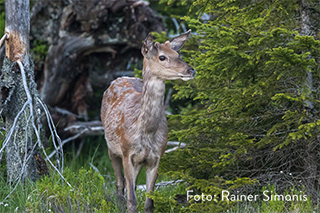Ungulate monitoring in german national parks
Motivation:
National parks aim at protecting biodiversity along with their underlying ecological structure and environmental processes. For this reason, there are no management interventions in the core areas of the national parks. However, for some species with large home ranges, protected areas in Central Europe are often too small to encompass the essential natural processes or at times don’t meet the species requirement for space and resources. Thus, management interventions in wildlife populations may be necessary in order to ensure the national park’s protective purpose and to prevent transmission of diseases as well as disproportionate damage to vegetation in the surrounding cultural landscape. The regulation of ungulate abundance therefore plays an important role in all German national parks. Except for ibex (Capra ibex) in the national park Berchtesgaden and row deer (Capreolus capreolus) in Hainich and Bayerischer Wald national park, all ungulate species are currently managed, leading to a hunting bag of each several hundred individuals per species every year. For this reason, the single protected area management processes have recently been thoroughly analyzed. One of the key findings is that ungulate monitoring as a basis of hunting quotas needs improvement, especially when considering the rapid methodological development in recent years. Another finding showed that there seems to be no coordination between the national parks in terms of indicators and methods for monitoring ungulate populations and their effects on vegetation.
Project aims:
The aim of this project is to develop a permanent monitoring design of wild ungulate populations and their effects on vegetation in the German national parks, also considering the requirements and demands of individual national parks. In addition, the implementation of a standardized database also aims at allowing causalities between single population parameters and ungulate effects on vegetation across different national parks.
Study design:
The project is divided into seven work packages:
- Compilation of specific goals and the current state of the single German national parks’ ungulate monitoring by means of a questionnaire
- Definition of indicators and selection of appropriate methods for monitoring ungulate populations by means of literature research
- Definition of indicators and selection of appropriate methods for monitoring ungulates’ effects on vegetation by means of literature research
- Test run for the population monitoring in selected national parks (Bayerischer Wald, Schwarzwald, Hainich, Kellerwald-Edersee, Müritz, Hunsrück-Hochwald sowie Naturschutzgebiet Königsbrücker Heide)
- Test run for the monitoring of ungulates‘ effects on vegetation in selected national parks (Bayerischer Wald, Schwarzwald, Hainich, Kellerwald-Edersee, Müritz, Hunsrück-Hochwald sowie Naturschutzgebiet Königsbrücker Heide)
- Implementation of a database for wildlife monitoring in the German national parks
- Evaluation of the results gained by the test runs and evaluation of the procedures
In the first step, a survey is conducted on the specific objectives and methods of the single national parks’ ungulate monitoring by means of a questionnaire. Based on these results, appropriate indicators for monitoring of ungulate populations and their effects on vegetation (in particular browsing) are defined and an analysis of existing monitoring methods is carried out. Subsequently, a test run for the population monitoring and the monitoring of ungulates’ effects on vegetation will be carried out in selected national parks. So far, six national parks have agreed to carry out the necessary field work. Finally, the data is analyzed and the procedures are evaluated together with the national park administrations, adjusting the procedures if necessary. As a result of the project, the selected methods are documented with the help of detailed protocols and data structures, allowing to adopt them in the protected areas’ long-term monitoring. The standardization of this approach is intended to strengthen cross-border cooperation and thus also to improve the management in the protection areas.
Funding:
- Bundesamt für Naturschutz (BfN)
Contact person:
Christian Fiderer
scientific Assistant
christian.fiderer@npv-bw.bayern.de
Prof. Dr. Marco Heurich
Head of department
marco.heurich@npv-bw.bayern.de
Collaborators:
- Nationalparkverwaltung Schwarzwald
https://www.nationalpark-schwarzwald.de/ - Eidgenössische Forschungsanstalt für Wald, Schnee und Landschaft
https://www.wsl.ch/ - Forschungsanstalt für Waldökologie und Forstwirtschaft, Rheinland-Pfalz
https://www.fawf.wald-rlp.de/ - Leibniz Institut für Zoo- und Wildtierforschung
https://www.izw-berlin.de/ - Säugetierkundliches Forschungsinstitut der Polnischen Akademie der Wissenschaften
https://www.zbs.bialowieza.pl/



